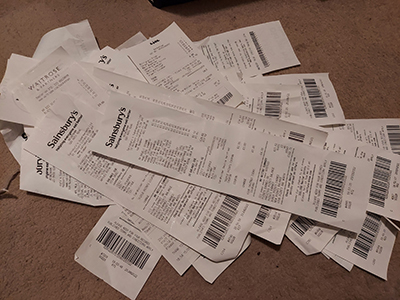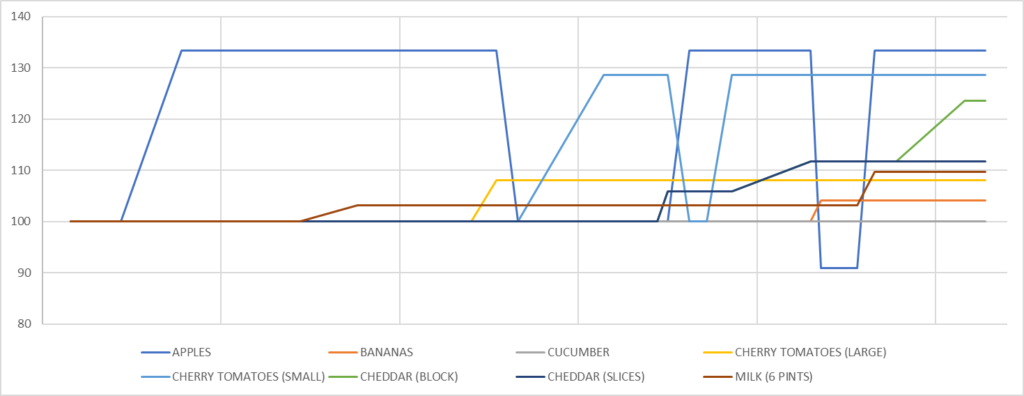The news keeps telling us that inflation is high and the price of shopping is going up. But can we trust the media, and just how high? Well, I went through 8 months worth of grocery receipts to find out.

I should first point out that this is my personal inflation level and yours will depend very much on what you buy. Fortunately for this investigation, I generally always shop at the same place and buy a lot of the same items each shop.

There’s some items I buy most shops and these are shown in the graph above. Bags of apples have fluctuated the most, varying between £1.10 and £1.60 over the last few months, probably because apples are often on sale. The next highest increase is for the small packs of cherry tomatoes which have gone up 28% (the large packs have only gone up 8%). The price of cheese also varies depending on what form it’s bought in. A 400g block of cheddar is now 23% more expensive than June last year, whilst packs of pre-sliced cheddar are only 11% more expensive. And 6 pints of semi-skimmed milk have gone up almost 10% in price, but 4 pint bottles have only gone up 5.5%.
Of my non-regular items, I discovered this week that 220g cans of Branston baked beans have gone up 37% after being stable for ages (was 40p per can, now 55p). In other big swings, wholewheat penne has gone up 27% from 55p per bag to 70p per bag.
Of fruit and vegetables, the only item which hasn’t changed price is cucumbers. Cucumbers have remained at a constant 43p for a standard non-large, non-organic cucumber. This is the same price as my local low-cost supermarket so I wonder if there’s some price competition going on here. (Loose onions have also stayed the same price, but I haven’t bought them for a while.)
And the one item that has come down in price is 1.25kg of sweet potatoes. Last June these cost £1.50 a bag, but they now cost just £1.11 a bag, a 24% reduction. And this one does have a sticker they’ve price-matched the low-cost supermarkets.
Long-life items such as cereal and toiletries appear to have remained relatively constant (or gone down), but I only buy these when they’re on offer and then I stock up for a while when I do, because that just makes sense. So fresh foods is really where the impact is going to be felt.
So is inflation real? Yes. How bad is it? Well, it depends entirely on what you buy (and in what packaging).
Full data (for items I’ve bought at least twice in the last 8 months):
Disclaimer: These prices are the most recent price I’ve paid, not necessarily their current prices.
| Was | Now | Change | |
| Apples (6x Royal Gala) | 1.20 | 1.60 | +33% |
| Bananas (Loose) | 0.73/kg | 0.76/kg | +4% |
| Baked beans (Branston 220g)* | 0.40 | 0.55 | +38% |
| Bacon (8 slices of back bacon)* | 1.25 | 1.50 | +20% |
| Branston pickle (small chunk)* | 2.50 | 2.50 | 0% |
| Bread – Kingsmill 50/50 sliced | 1.00 | 1.00 | 0% |
| Bread – Wholemeal seeded loaf | 1.10 | 1.20 | +9% |
| Cereal – Special K (Peach and Apricot)* | 2.00 | 2.00 | 0% |
| Cereal – Raspberry and Yoghurt Crisp* | 1.50 | 1.50 | 0% |
| Cereal – Shreddies* | 3.00 | 3.00 | 0% |
| Cereal – Weetabix Mini (Chocolate)* | 2.00 | 2.00 | 0% |
| Cheddar (400g) | 1.70 | 2.10 | +24% |
| Cheddar (10 slices) | 1.70 | 1.90 | +12% |
| Cherry tomatoes (330g) | 0.70 | 0.90 | +28% |
| Cherry tomatoes (500g) | 1.25 | 1.35 | +8% |
| Cucumber (whole) | 0.43 | 0.43 | 0% |
| Deodorant* | 1.46 | 1.75 | +20% |
| Milk – Semi-skimmed (4 pints) | 1.09 | 1.15 | +6% |
| Milk – Semi-skimmed (6 pints) | 1.55 | 1.70 | +10% |
| Pasta – Wholewheat penne* | 0.55 | 0.70 | +27% |
| Onions (Loose)* | 0.85/kg | 0.85/kg | 0% |
| Pasta bake sauce* | 1.70 | 1.00 | -41% |
| Shampoo* | 3.50 | 3.50 | 0% |
| Shower gel* | 2.20 | 1.25 | -43% |
| Sweet potatoes (1.25kg)* | 1.50 | 1.11 | -24% |
